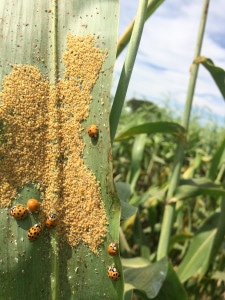A new pest, the sugarcane aphid, made its first appearance in Tennessee sorghum in 2014. I’m hearing a lot of interest about increasing sorghum acreage this year, and this is a pest we need to think about in advance. The sugarcane aphid was first found as an economic pest in 2013, primarily in Texas and Louisiana. In 2014, it spread across the South. This insect is capable of causing substantial damage to sorghum, and it is expensive and relatively difficult to control. Fortunately it only found its way into West Tennessee in late July or early August, and it was only late planted sorghum that was seriously affected. It also caused some serious damage to sweet sorghum. Johnsongrass in an important alternate host.
 What should you expect in 2015? We’ve learned a lot, but we still have a ways to go. The biggest question in my mind is where this pest will overwinter. It is believed it can only survive winter on green tissue (i.e., it does not have an overwintering or diapause stage). If this is true, then we can expect a winter kill in Tennessee, and it will be forced to migrate northward each year. That could be a big help, allowing us to largely escape infestations on early planted sorghum. However, we don’t really know how far north sugarcane aphids will overwinter, and we do know it is capable of rapid migration.
What should you expect in 2015? We’ve learned a lot, but we still have a ways to go. The biggest question in my mind is where this pest will overwinter. It is believed it can only survive winter on green tissue (i.e., it does not have an overwintering or diapause stage). If this is true, then we can expect a winter kill in Tennessee, and it will be forced to migrate northward each year. That could be a big help, allowing us to largely escape infestations on early planted sorghum. However, we don’t really know how far north sugarcane aphids will overwinter, and we do know it is capable of rapid migration.
My counterparts at Mississippi State University just posted a great article about the management of sugarcane aphids (see link below). Anyone growing sorghum in 2015 should read this article. The core of this program is to plant early, use an insecticide seed treatment, avoiding unnecessary insecticide applications that may disrupt populations of beneficial insects, increase your scouting efforts, and make well timed and quality insecticide applications as needed. Some observations suggests aphid populations were higher where stands were thin, so they also suggest avoiding thin stands or using a narrower row spacing. I suggest staying up date about the current situation by following blog articles like this one.
Management Guidelines for Sugarcane Aphids in MS Grain Sorghum 2015
By Angus Catchot, Extension Entomologist, Jeff Gore, Research and Extension Entomologist And Don Cook, Research Entomologist, On February 24th, 2015

